Si3N4 Bonded SiC Products
Si3N4 combined with SiC products is combined with phase Si2N4 Si3N4 / SiC refractory compound phase, for SiC products the main crystal phase, second phase for ɑ - Si3N4 and beta Si3N4, usually contains a small amount or trace of Si2N2O and free Si. Different manufacturer's products on the phase composition of slightly different, as shown in table 14-113. In most Si3N4 combined with SiC products, combined with phase Si3N4 usually give priority to with ɑ - Si3N4. Si3N4 hexagonal system, generally divided into two phase: ɑ and beta phase. Are composed of [Si3N4] tetrahedra. In terms of structure, s-si3n4 has higher symmetry, smaller molar volume, and is also a thermodynamically stable phase at temperature. ɑ - Si3N4 more easily into on kinetics, high temperature (1400 ~ 1800 ℃), ɑ heavy configuration phase transformation in the meeting, the irreversible into beta phase. ɑ - Si3N4 white or grey or spicules loose wool, beta Si3N4 is dense granular polyhedron or columnar. For Si3N4 bonded SiC products, the difference in phase composition will affect the microstructure and properties of the materials. Most Si3N4 combined with SiC products at home and abroad, the matrix part usually by more quantity of fibrous or acicular ɑ - Si3N4, a small amount of granular or columnar beta Si3N4 and SiC particles, Si3N4 interwoven into three-dimensional network, the SiC particles together. Figure 14 to 18 for Si3N4 combined with SiC sample (from Sicatec75) fracture surface SEM photos, well developed in the pore visible fibrous ɑ - Si3N4, local visible granular beta Si3N4, this kind of microstructure is currently the most typical Si3N4 combined with SiC products.
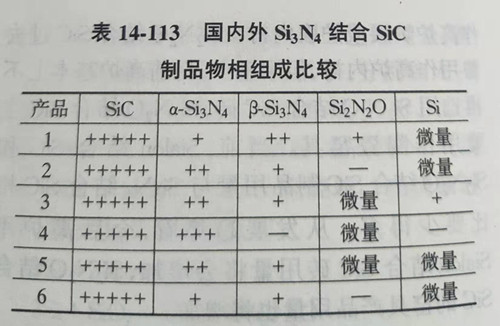
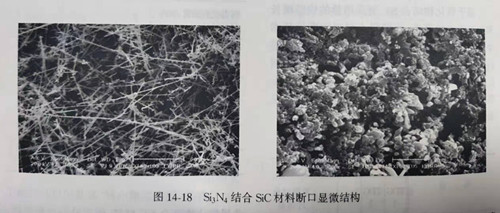
The mechanical properties of Si3N4 combined with SiC materials at high temperature are excellent, and the creep resistance is excellent. Under the load of 0.2mpa, the starting point of softening under load is greater than 1800℃.
Figure 14-19 shows the relationship between the flexural strength of Si3N4 bonded SiC material and temperature. The flexural strength of the material usually increases with the increase of temperature, reaches the peak at 800℃ and maintains until 1400℃, and then decreases sharply with the rise of temperature, but still about 30MPa at 1600℃. At present, the flexural strength of most domestic and foreign products at 1400℃ is higher than that of normal temperature. Some researchers believe that the reasons for this result are as follows:
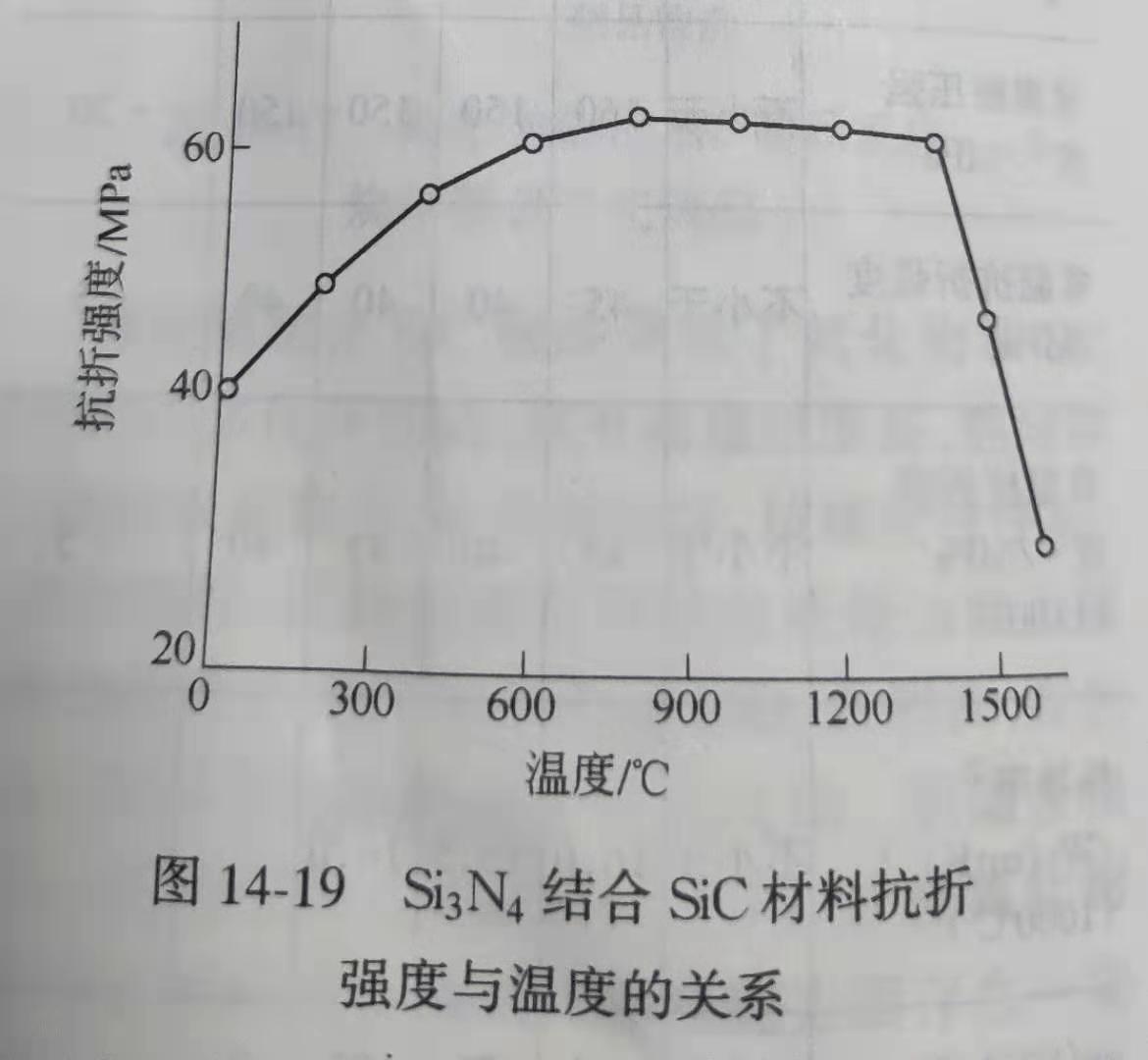
(1) high temperature oxidation passivates the crack tip and reduces the porosity;
(2) stress relief and microcrack healing at high temperature.
The thermal conductivity of Si3N4 bonded SiC material is high, as shown in figure 14-20. With the increase of temperature, the thermal conductivity decreases gradually. The linear expansion coefficient of Si3N4 bonded SiC material is small, as shown in figure 14-21.
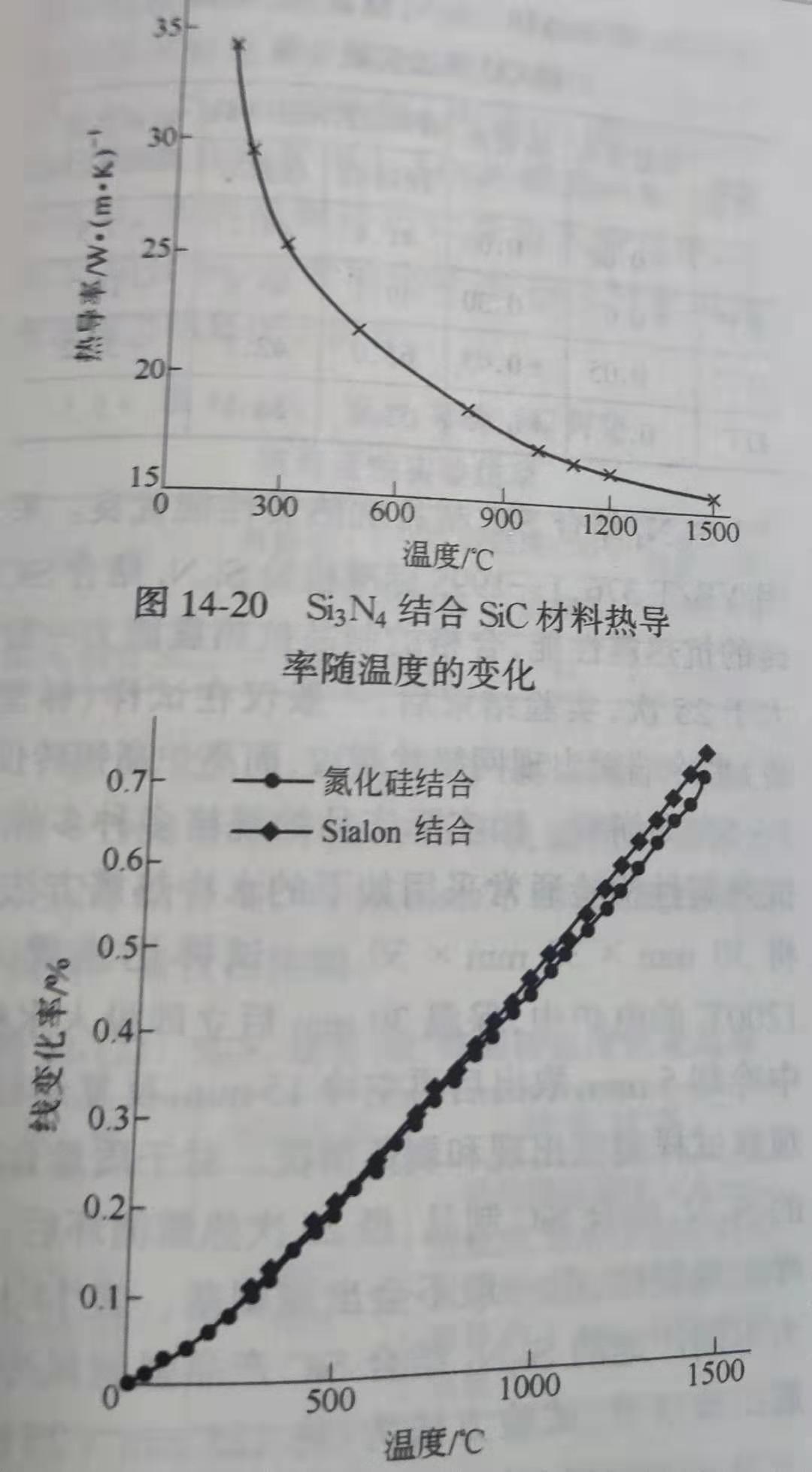
Si3N4 combined with SiC products has excellent resistance to alkali erosion. Table 14-115, table 14-116 and table 14-117 show the results of alkali corrosion resistance tests under different experimental conditions. Table 14-115 the test method adopted is as follows: 125mm×25mm×25mm bar sample was placed in the crucible, buried with anhydrous K2CO3 and coke powder (mass ratio 1:1), and calcined at 1300℃ for 10h. Table 14-116 test method:
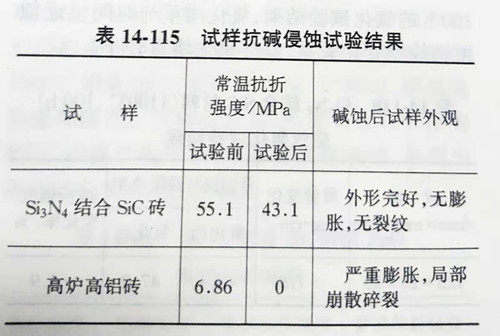
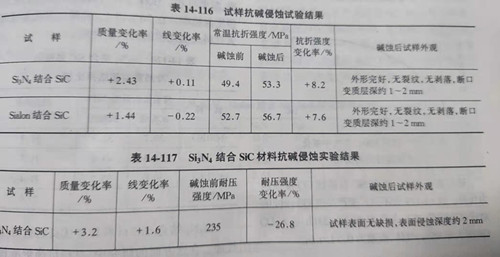
125mm×25mm×25mm samples were buried in a crucible with anhydrous K2CO3 and coke powder (mass ratio 1:4), calcined at 1300℃ for 5h, and repeated for 5 times. Table 14-117 shows the test results of alkali corrosion resistance of Si3N4 combined with SiC products based on GB/T 14983-1994 method. The test erosion time is 3h.
Si3N4 combined with SiC products has good antioxidant properties. The research shows that the high-temperature oxidation process of Si3N4 combined with SiC materials in the mixed gas phase of air, water vapor and different CO/CO2 ratios basically follows the parabolic oxidation law. The early stage is the chemical reaction control phase, and the later stage is the diffusion control phase. When the material is used in a high temperature oxidizing atmosphere, a dense SiO2 protective layer will be formed on the surface, which is conducive to preventing further oxidizing erosion, showing protective oxidation.
Table 14-118 shows the antioxidant test results of the samples at 1100℃ and 100h in the air. After the samples were oxidized, their mass changed little and their strength did not change much, showing excellent antioxidant properties. FIG. 14-22 shows the oxidation test results of 50mm×25mm×25mm samples kept at 1350℃ in the air for 20h, 40h and 60h respectively. With the increase of oxidation time, the oxidation gain tends to be slow, showing protective oxidation characteristics. Figure 14-23 shows the oxidation test results of 33mm×33mm×33mm samples kept at 950℃ in the air for 0~100h. The relationship between oxidation weight gain and time is approximately parabolic, and the final oxidation weight gain is small.
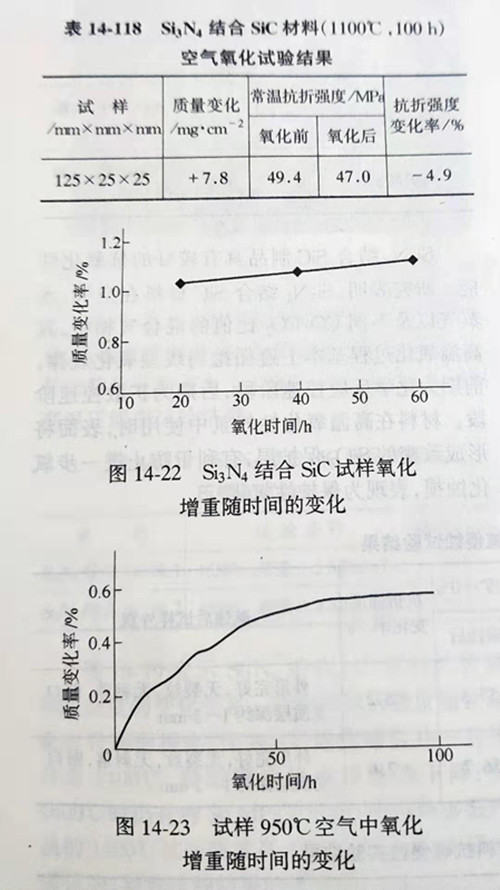
The results show that Si3N4 combined with SiC has excellent CO resistance. Table 14-119 shows the comparative test results of different manufacturers' products against CO erosion. The experimental conditions are as follows: 500℃,200h, CO (purity > 95%) gas, flow rate 0.5L/min.
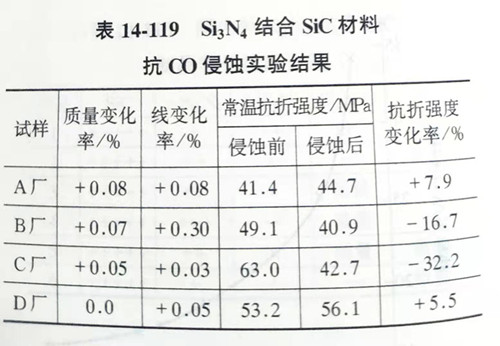
Si3N4 combined with SiC has excellent thermal shock resistance. The thermal shock resistance of Si3N4 combined with SiC products was tested by YB/T 376.1-1995 standard, and the thermal shock resistance of qualified products was generally greater than 25 times. After the experiment, the network crack only appeared on the water-cooled end face of the sample (standard brick), while the high-alumina brick of blast furnace cracked only 3-5 times. Due to the variety of specifications of the actual products, the thermal shock resistance test usually adopts the following hydro-thermal shock method: the sample of 30mm×30mm×30mm is quickly placed into an electric furnace at 1200℃, kept warm for 30min and then immediately put into the water tank for cooling for 5min. After being taken out, it is then air-cooled for 15min. For Si3N4 combined with SiC products of qualified quality, after 25 thermal shock cycles, the samples crack, but generally do not appear peeling. Table 14-120 shows the results of Si3N4 from different producing areas combined with SiC products' forced wind cooling and thermal shock experiments. The test method is as follows: 125mm×25mm×25mm samples (cut from bricks) are quickly placed into an electric furnace at 1200℃, kept warm for 30min, then immediately put into a water tank for 5min, and then air cooled for 15min after removal. For Si3N4 combined with SiC products of qualified quality, after 25 thermal shock cycles, the samples crack, but generally do not appear peeling. Table 14-120 shows the results of Si3N4 from different producing areas combined with the thermal shock test of SiC products by forced wind. The test method is: 125mm×25mm×25mm samples (cut from the bricks) are quickly placed into an electric furnace at 1350℃, and the samples are taken out for 15min and forced air cooled to room temperature, repeatedly for 5 times. After severe thermal shock, the flexural strength retention rate of the samples was above 70%, showing the thermal shock resistance incomparable to other conventional refractories.
Si3N4 combined with SiC material has excellent slag erosion resistance. In this aspect of the research, the material resistance to blast furnace slag erosion more research. Table 14-121 shows the erosion test results of the samples against high titanium blast furnace slag. The test method was as follows: 125mm×25mm×25mm samples were placed in a crucible, buried in high-titanium blast furnace slag powder, and kept at 1450℃ in an electric furnace for 5h. After the test, the blast furnace high aluminum brick has been completely fused into the slag fluid, but the Si3N4 combined with SiC brick is in good shape, erosion is not obvious, slag erosion resistance is obviously better than the former.
Table 14-122 shows the experimental results of rotating slag erosion resistance of Si3N4 combined SiC bricks using GB/T 8931-1988 standard method. Si3N4 combined SiC bricks (Sicatec75 bricks) show excellent resistance to blast furnace slag erosion.
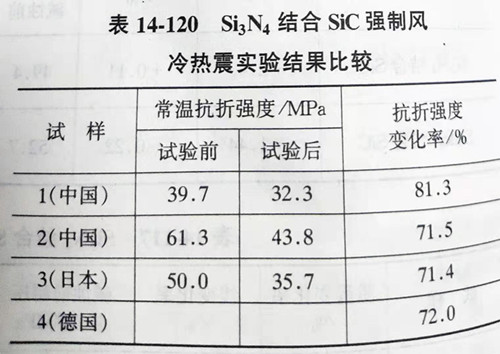
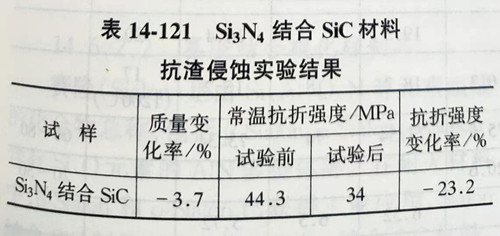
Si3N4, Si2N2O and Sialon combined SiC materials have excellent cryolite erosion resistance, among which Si3N4 combined with SiC has the best erosion resistance, and Si3N4 combined with SiC has significantly better electrolyte permeability than Si2N2O combined with Sialon. For Si3N4 combined with SiC materials, generally, the lower the apparent porosity of the materials, the better the erosion resistance of cryolite.
Si3N4 combined with SiC has excellent resistance to ZnO erosion. Table 14-123 shows the test results of the sample's resistance to ZnO erosion. The test method was: 125mm×25mm×25mm samples were oxidized at 1200℃ in the vapor atmosphere for 100h in advance. Furnace ash (fe2o385.36,SiO26.59, Al2O3 3.70,CaO2.02,MgO 0.71,ZnO 0.65,MnO 0.33,SO3 0.46,P2O5 0.18) was mixed with industrial ZnO fine powder to form furnace ash with ZnO concentration of 10%, 15% and 20% respectively. The oxidized samples were placed in saggers, buried with furnace ash of different ZnO concentrations, and then covered with graphite powder of the same ZnO concentration. The saggers were sealed with a cover plate and fire mud, and calcined at 1500℃ for 20h in an electric furnace. After the samples were washed and dried, their mass and strength were tested. After the erosion of the sample, the external size hardly changed, the mass changed very little, and the strength slightly increased, showing excellent resistance to ZnO erosion.
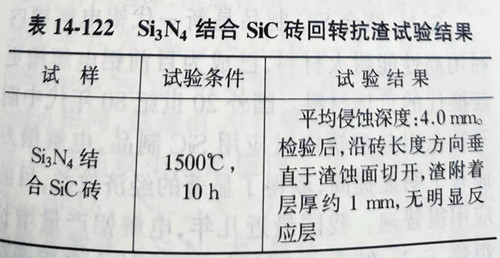
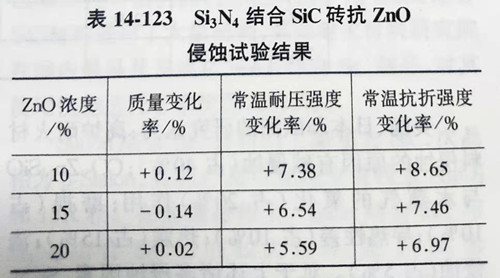
At present, China's Si3N4 combined SiC products production technology has been very mature, domestic Si3N4 combined SiC product technology physical and chemical performance indicators have been international advanced level, see table 14-124. Fine Si3N4 combined with SiC products in the table can be regarded as a kind of structural ceramics material, usually adopt high purity of SiC and Si powder as raw materials, vacuum or pressure grouting molding body, nitride reaction sintering, and other products, mainly used for the production of hollow beams is particularly suitable for below 1450 ℃, high load conditions, to use its cost performance is better than that of recrystallization SiC products, but the dosage is not big.
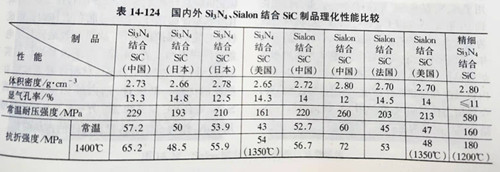
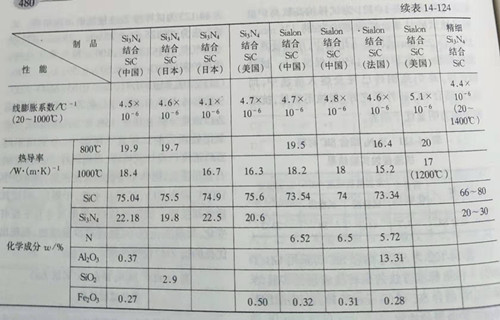
Studies in the United States, Japan and Europe suggest that alkali erosion (40%) is the cause of blast furnace refractory erosion. Oxidation of CO.Zn.SiO with water vapor (20%); Wear and tear (10%); Poor thermal conductivity (10%); Thermal shock (15%); Slag erosion (5%). For the above erosion factors,Si3N4, combined with SiC material has excellent corrosion resistance, is an ideal material for blast furnace lining. SiC bricks were used in blast furnaces in the 1970s. From the late 1970s to the early 1980s, SiC bricks combined with SiC were mainly used. In the late 1980s, except for Japan, the use of si-sic combined SiC bricks decreased year by year, accounting for only 20%, while the use of Si3N4 combined SiC bricks increased year by year. According to statistics, from 1982 to 1990, the world's blast furnace needs about 10,000 tons of SiC bricks every year, 85% of which is Si3N4 combined with SiC bricks. At present,Si3N4 combined SiC products have been widely used in large blast furnaces at home and abroad, the first generation of blast furnace life has been extended to 10 or more than 15 years,Si3N4 combined with SiC material has become the preferred senior lining material for large blast furnaces today. In recent years, China's iron and steel industry has developed rapidly, and it is remarkable to build new large blast furnaces and to expand the capacity of blast furnace overrepair. Si3N4 combined SiC bricks are used in the lining or cooling wall of newly built blast furnaces.
Si3N4, combined with SiC products, is a new generation of high performance refractory material for the lining of aluminum electrolysis cell, and has become the preferred material for the replacement of aluminum electrolysis cell. SiC products have been applied to aluminum electrolytic cell lining since the middle of 1980s. The life of electrolytic cell has been significantly improved and remarkable economic benefits have been obtained. In recent years, the production of electrolytic aluminum has increased rapidly in China. Si3N4 combined with SiC material has been gradually recognized by many aluminum companies, and its consumption has increased year by year, making it the preferred material for aluminum electrolytic cells in China. Aluminum electrolytic cell lining using Si3N4 combined with SiC products has the following advantages:
(1) reduce the horizontal current of the tank, increase the side heat dissipation, reduce the tank temperature, improve the current efficiency, reduce the dc power consumption, and play a role in energy saving and consumption reduction;
(2) the service life of the electrolyzer is prolonged. Si3N4 combined with silicon carbide brick has good thermal conductivity, good resistance to cryolite erosion, oxidation resistance and erosion resistance, and can form a thick and stable protective cover on the working surface, thus effectively extending the service life of the electrolyzer. Table 14-125 shows the experimental statistical results of an aluminum plant in China. Si3N4 combined with SiC material has obvious advantages over ordinary carbon blocks. According to statistics, the annual demand of Si3N4 combined SiC products for aluminum electrolysis cells at home and abroad is about 25,000 ~ 30,000 t, and Si3N4 combined SiC products for aluminum electrolysis cells have a broad market prospect.


